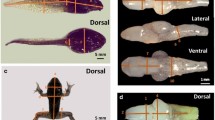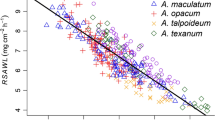Abstract
Phenotypic plasticity is adaptive for an organism inhabiting a variable environment if the optimal phenotype of a trait that affects fitness varies with environmental conditions, and if the organism can perceive environmental conditions and respond appropriately. Wilbur and Collins have proposed that amphibian larvae might respond adaptively to changes in their resource environment. If conditions for growth in the aquatic environment deteriorate, then a tadpole should metamorphose earlier and smaller than a tadpole under constant high growth conditions. Several experiments on a variety of species have tested this prediction, but only one demonstrated such a response. That experiment involved Couch's spadefoot toads (Scaphiopus couchii) and employed a gradual decrease in food level, whereas the others all used an abrupt switch from high to low food. The purpose of the present experiment was to examine the response of S. couchii to an abrupt change in food level, and to determine if the response depended on the level of two other factors, density and temperature, that also affect larval development. The average effects of the abrupt change in food level were similar to those seen in studies on other species: age at metamorphosis was primarily determined by the early food regime, and size at metamorphosis was determined by food level late in the larval period, suggesting that the effect of decreased food depends on how the food change is done. However, the response to even an abrupt food change depended on interactions with other environmental factors. At high temperature, high initial food, and low density, development was very rapid and tadpoles switched from high to low food metamorphosed at about the same time and size as those at constant high food. In contrast, under high temperature and high initial food conditions, but at high density, tadpoles switched to low food metamorphosed somewhat earlier and smaller, on average, than tadpoles kept at high food. At low temperature, the direction of response depended on density: tadpoles metamorphosed much smaller and slightly, but significantly, earlier at low density, but smaller and later at high density. The developmental response to increased food also varied with temperature. Larvae at high temperature metamorphosed earlier and larger than those at constant low food. At low temperature, larvae metamorphosed larger, but at nearly the same time as their counterparts at constant low food. The combination of high density and constant low food prevented any tadpoles from metamorphosing at high temperature, and allowed relatively few metamorphs at low temperature. Under conditions which impose either very rapid or retarded development, the opportunity to respond to altered food level may be limited. Interactions among environmental factors, therefore, may constrain responses to changing conditions, and may even prevent completion of development.
Similar content being viewed by others
Author information
Authors and Affiliations
Additional information
Received: 3 February 1997 / Accepted: 2 October 1997
Rights and permissions
About this article
Cite this article
Newman, R. Ecological constraints on amphibian metamorphosis: interactions of temperature and larval density with responses to changing food level. Oecologia 115, 9–16 (1998). https://doi.org/10.1007/s004420050485
Issue Date:
DOI: https://doi.org/10.1007/s004420050485




